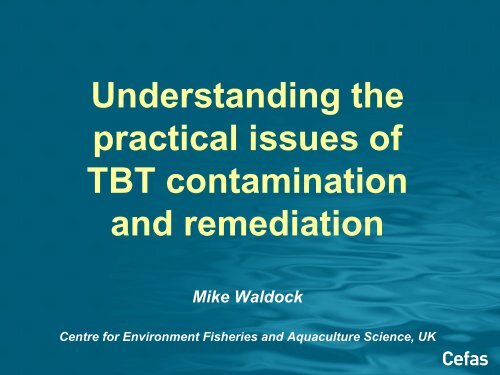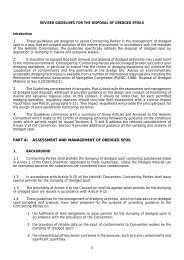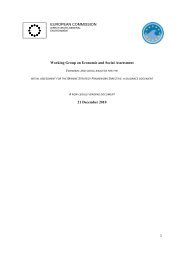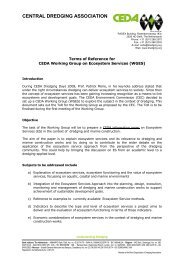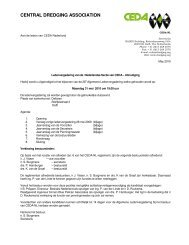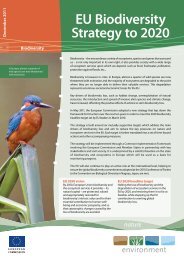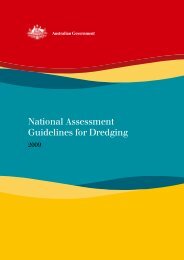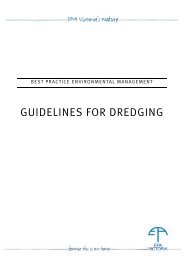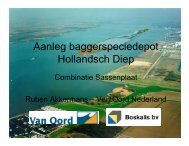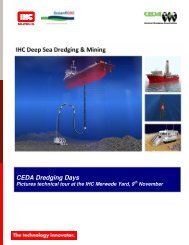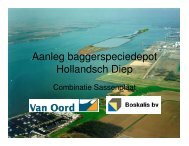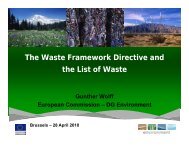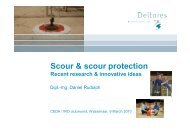Understanding the practical issues of TBT contamination and ...
Understanding the practical issues of TBT contamination and ...
Understanding the practical issues of TBT contamination and ...
You also want an ePaper? Increase the reach of your titles
YUMPU automatically turns print PDFs into web optimized ePapers that Google loves.
<strong>Underst<strong>and</strong>ing</strong> <strong>the</strong><br />
<strong>practical</strong> <strong>issues</strong> <strong>of</strong><br />
<strong>TBT</strong> <strong>contamination</strong><br />
<strong>and</strong> remediation<br />
Mike Waldock<br />
Centre for Environment Fisheries <strong>and</strong> Aquaculture Science, UK
Issue<br />
• By <strong>the</strong> mid 1990’s <strong>TBT</strong> <strong>contamination</strong> <strong>of</strong> sediments<br />
became <strong>the</strong> most common reason for refusal <strong>of</strong> a licence<br />
for disposal <strong>of</strong> dredged material.<br />
• Values up to 100ppm.<br />
• Concs patchy <strong>and</strong> pointed to paint material entrained in<br />
sediments.<br />
• Biological availability <strong>of</strong> paint <strong>and</strong>/or remediation<br />
possibilities were not clear.<br />
• Defra sponsored a programme with Cefas between 1999<br />
<strong>and</strong> 2002 to inform <strong>the</strong> risk assessment process. Project<br />
leader – Jacquie Reed
Extent <strong>of</strong> <strong>the</strong> Problem<br />
<strong>TBT</strong><br />
Levels<br />
(mg/kg)<br />
1998 1999 2000 2001<br />
Total levels 1992-<br />
2001<br />
0-0.1 52% 46% 60% 65% 52% (1511)<br />
0.1-1 38% 31% 32% 32% 30% (1049)<br />
1-10 9% 17% 7% 3% 10% (293)<br />
>10 1% 6% 0% 0% 2% (68)<br />
2921<br />
R. Tyne,Southampton Water, R. Tees, R. Mersey, R.<br />
Humber <strong>and</strong> Newport, Barry <strong>and</strong> Cardiff.
Some Questions<br />
• How much is adsorbed to <strong>the</strong> sediment,<br />
entrained small/large paint particles?<br />
• What sort <strong>of</strong> sediments are we dealing with?<br />
• Is <strong>TBT</strong> more persistent or less persistent as<br />
paint?<br />
• Is it more or less toxic as paint?<br />
• Is <strong>the</strong>re evidence <strong>of</strong> harm at disposal sites?<br />
• Do <strong>the</strong> different sediment types/<strong>TBT</strong> forms<br />
respond differently to remediation?<br />
• Is remediation cost-effective/fit in policy<br />
framework?
<strong>TBT</strong><br />
Waste paint<br />
(i)<br />
(ii)<br />
(iii)<br />
Sediment<br />
Large paint chippings<br />
Small paint particles<br />
<strong>TBT</strong> adsorbed to sediments
•<br />
90<br />
80<br />
What sort <strong>of</strong> sediment particles is <strong>the</strong> <strong>TBT</strong><br />
associated with?<br />
% <strong>of</strong> Particles with Size < 63 µm<br />
70<br />
60<br />
50<br />
40<br />
30<br />
20<br />
10<br />
0<br />
0 20 40 60 80 100 120<br />
<strong>TBT</strong> Concentrations (mg/kg)
Forms <strong>of</strong> <strong>TBT</strong>
<strong>TBT</strong> persistence<br />
Fig 1. Flow-through 12°C, surface sediment<br />
Concentration <strong>of</strong> <strong>TBT</strong><br />
µg/g dry wt<br />
0.40<br />
0.30<br />
0.20<br />
0.10<br />
0.00<br />
0 500 1000 1500<br />
Day<br />
Concentration <strong>of</strong><br />
<strong>TBT</strong> µg/g dry wt<br />
0.50<br />
0.40<br />
0.30<br />
0.20<br />
0.10<br />
0.00<br />
Fig 10. Flow-through 12°C, anaerobic<br />
sediment<br />
0 500 1000 1500<br />
Day
<strong>TBT</strong> persistence<br />
Concentration <strong>TBT</strong><br />
ug/g dry wt<br />
12<br />
10<br />
8<br />
6<br />
4<br />
2<br />
0<br />
Artificially contaminated 12 C,<br />
anaerobic sediment<br />
0 200 400 600 800 1000 1200<br />
Day
<strong>TBT</strong> <strong>and</strong> Metals in Lake<br />
2000<br />
Sediments<br />
Mollusc shell<br />
fragments<br />
reappear<br />
1960<br />
Cu Hg <strong>TBT</strong><br />
Loss <strong>of</strong><br />
mollusc shell<br />
fragments<br />
change to<br />
diatom<br />
dominated<br />
community
Toxicity<br />
Arenicola<br />
Corophium
Short <strong>and</strong> medium-term toxicity
<strong>TBT</strong> toxicity<br />
100<br />
Arenicola<br />
% dead<br />
<strong>TBT</strong>O<br />
Paint<br />
100<br />
0<br />
Control 0.1 1 10<br />
Corophium<br />
<strong>TBT</strong> (ppm)<br />
% dead<br />
<strong>TBT</strong>O<br />
Paint<br />
0<br />
Control 0.1 1 10<br />
<strong>TBT</strong> (ppm)
Sublethal response <strong>of</strong> paint-derived <strong>TBT</strong><br />
using A. marina (T=30 days)<br />
Mean casting per replicate<br />
125<br />
100<br />
Number <strong>of</strong> casts<br />
75<br />
50<br />
25<br />
0<br />
control 0.95 mg.kg 2.21 mg.kg 2.96 mg.kg 7.80 mg.kg 8.00 mg.kg<br />
<strong>TBT</strong> Concentration
Disposal sites<br />
• Is <strong>the</strong> current risk assessment right for disposal<br />
sites?<br />
River Tyne<br />
0 1<br />
2<br />
Kilometres<br />
N<br />
0.30 ppm <strong>TBT</strong><br />
0.15 ppm <strong>TBT</strong><br />
0.03 ppm <strong>TBT</strong><br />
Stn. 32<br />
Tyne Dock<br />
disposal<br />
ground<br />
Stn. 33<br />
Stn. 39<br />
Stn. 37
Changes in me<strong>of</strong>aunal ecology.<br />
<strong>TBT</strong>-Transect <strong>of</strong>f <strong>the</strong> Tyne 2000<br />
Square-root transformation<br />
Stress 0.15<br />
39<br />
32<br />
N<br />
39<br />
32<br />
River Tyne<br />
37<br />
39<br />
37<br />
37<br />
39<br />
37<br />
33 33<br />
32<br />
Stn. 32<br />
Stn. 33<br />
Stn. 39<br />
Tyne Dock<br />
disposal<br />
ground<br />
Stn. 37<br />
33<br />
33<br />
32<br />
0 1<br />
Kilometres<br />
2<br />
Station 32 inside <strong>the</strong> disposal ground<br />
Station 33 inside <strong>the</strong> disposal ground (south <strong>of</strong> stn. 32)<br />
Station 39 outside <strong>the</strong> disposal ground (south <strong>of</strong> stn. 33)<br />
Station 37 outside <strong>the</strong> disposal ground (south <strong>of</strong> stn. 39)
Stage 3 imposex in female whelk
Dogwhelks<br />
N<br />
St. Mary's Lighthouse<br />
4<br />
3<br />
1<br />
2<br />
River Tyne<br />
Souter Lighthouse<br />
S
Results<br />
Incidence <strong>of</strong> Imposex in Dogwhelks After 6 months<br />
100.0%<br />
90.0%<br />
80.0%<br />
70.0%<br />
60.0%<br />
50.0%<br />
40.0%<br />
30.0%<br />
20.0%<br />
10.0%<br />
0.0%<br />
Incidence <strong>of</strong> Imposex<br />
6 Month<br />
Control<br />
South <strong>of</strong> River<br />
Mouth<br />
North <strong>of</strong> River<br />
Mouth<br />
Site 4 Site 2
<strong>TBT</strong> in Marine Mammals<br />
<strong>TBT</strong> in Porpoise liver<br />
Northumb<br />
Tyne &W<br />
Teeside<br />
N Yorks<br />
Lincs<br />
Norfolk<br />
Suffolk<br />
Essex<br />
0 50 100 150 200<br />
µg/Kg<br />
<strong>TBT</strong><br />
Highest concentrations<br />
close to Tyne estuary
Remediation
Summary <strong>of</strong> Techniques<br />
Technique £/m 3<br />
Mechanical Separation 5 - 35<br />
Sediment Washing 25<br />
Physico-chemical Extraction 30 – 210<br />
Wet air oxidation, base<br />
catalysed decomposition<br />
30 – 735<br />
Biological Microbial degradation 30 - 140<br />
Thermal Thermal desorption 55 - 200<br />
Immobilisation 30 – 125<br />
Incineration 1000 – 2000<br />
After Burt & Fletcher, 1999
Steam Stripping<br />
Process<br />
• Method developed in Germany (Eschenbach et<br />
al., 2001)<br />
• Remediates <strong>TBT</strong>, PAH <strong>and</strong> mineral oil in<br />
sediment <strong>and</strong> soil systems.<br />
• Treatment <strong>of</strong> contaminated fine-grained<br />
particles<br />
• Cleaning performances > 95%<br />
• 14ppm Tyne sample – 0.1ppm +0.004ppm
Favoured Techniques<br />
Mechanical<br />
Hydrocyclone:<br />
• Exploit differences in size <strong>and</strong> density between<br />
paint flakes <strong>and</strong> particles for separation <strong>of</strong><br />
contaminated material. If <strong>TBT</strong> concentrated in<br />
particular sediment size fraction, contaminated<br />
material can be separated. Low cost <strong>and</strong> can be<br />
incorporated on board a vessel.
<strong>TBT</strong> particles in sediments<br />
Sediment contaminated at 4ppm<br />
38µm 63µm 125µm 250µm 500µm<br />
light 0.73 0.97 3.25 11.48 8.1<br />
medium 0.44 0.22 2.05 1.85 4.01<br />
heavy 0.21 0.32 0.2 1.84 3.46<br />
Volume <strong>of</strong> banned material reduced by<br />
up to 80%
<strong>TBT</strong> winnowing effect<br />
<strong>TBT</strong> Concentration (mg/kg)<br />
6.2<br />
6<br />
5.8<br />
5.6<br />
5.4<br />
5.2<br />
5<br />
4.8<br />
4.6<br />
4.4<br />
Flume T=3 hrs<br />
100 200 300<br />
Distance (mm) from w ater flow<br />
0-4cm<br />
4-8cm<br />
8-12cm
Conclusions<br />
• Chemical analysis <strong>of</strong> concentrations <strong>of</strong> <strong>TBT</strong> in sediment<br />
can be misleading.<br />
• Heavily contaminated sediments have <strong>TBT</strong> as both<br />
entrained particles <strong>and</strong> adsorbed.<br />
• Entrained paint is less toxic in <strong>the</strong> short term, but more<br />
persistent<br />
• Risk analysis analysis at disposal sites showed that <strong>TBT</strong><br />
is largely contained at <strong>the</strong> sites <strong>and</strong> is breaking down in<br />
<strong>the</strong> disposed sediment<br />
• <strong>TBT</strong> burdens can be reduced by mechanical methods<br />
(lab only)


